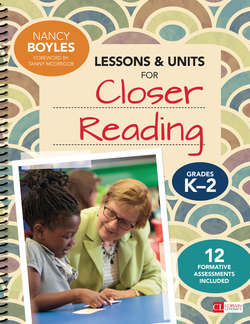Читать книгу Lessons and Units for Closer Reading, Grades K-2 - Nancy Boyles - Страница 8
На сайте Литреса книга снята с продажи.
Foreword
ОглавлениеTanny McGregor
No doubt about it, I’m a middle-aged teacher. Like most teachers around my age, I often look back at education and think about how things have changed. Take picture books, for example. I remember how, in the 1980s, finding a great picture book would energize my spirit and serve as the foundation for solid instruction in my classroom. I could cross the curriculum with a picture book. I could integrate the arts, stimulate meaningful conversation, and give my students yet another opportunity to love reading a little bit more. I recall countless conversations with colleagues about books and authors, about units and ideas. In the hallway, the parking lot, and even in the ladies room, we talked about picture books.
It sure seems like things have changed. One of my teaching partners recently said to me wistfully, “Remember when we used to get together and talk about books?” The teachers I know feel so bogged down with mandates, assessments, and increasing workloads that conversations about books seem a luxury, something from a gilded age of teaching and learning that has slipped into the past. Many of the topics that occupy our thought life now seem to drain our energy, not charge it. If we are not careful, we might wake up one day to realize our instruction has become about toeing the line rather than teaching the child—and bland, like our lives would become without books.
It does not have to be this way. Even with changing standards and a restless political atmosphere, meaningful instruction can still hold its own, and picture books can actually work to unite all the disparate instructional pieces. Yes, some things have changed. But some things will always stay the same: we need picture books. They can help us make meaning out of the chaos in our lives, and, most important of all, books bring a child into an everlasting relationship with reading.
So it is a rather happy event that Lessons and Units for Closer Reading, Grades K–2 is entering our teaching lives because Nancy Boyles understands. She knows how so much around us has changed. She recognizes the current state of affairs, but she holds on tightly to what matters in the classroom. In this book, Nancy takes what some think of as “new” instructional terms and demands, like rigorous standards, complex text, and close reading, and shows how these practices can live in harmony with beautiful, engaging picture books. She shows us that close, attentive reading of an author and illustrator’s meaning is, to quote the Talking Heads, same as it ever was. So this book reassures teachers like me to the same degree that it instructs.
It is no accident that Nancy uses words like coherence, connections, and global understandings in these pages. Through her unit and lesson design, she brings that coherence to us in incremental, practical ways—ways that new and experienced teachers can easily absorb into their teaching practices. Nancy is giving us what we want—specific lesson ideas based on a solid framework that uses children’s literature—but it is actually what we need, too. We need to be reminded that the rigor and cognitive demand that some think of as 21st century instruction can meld with the beauty and simplicity of words and pictures . . . in books made for children.
